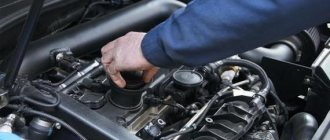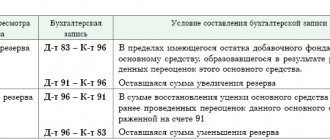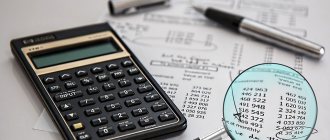345
12.05.2021
There is no mention in the Tax Code of “the main means of tax accounting.” Instead, “depreciable property” is used - assets exceeding 100,000 rubles, called “fixed assets” in accounting, where the main unit is an inventory item. The tax accounting procedure is constantly being modified; a number of innovations were also registered in 2022.
Depreciable property is not initially intended for subsequent sale; it is used by the company for other purposes. Subsequently, the object is resold, given for free use, if it is unsuitable, there is no need for further use.
What applies to fixed assets
Property of an organization with a useful life of more than 12 months, worth more than 100,000 rubles, used as means of labor for the production and sale of goods (works, services), or for management purposes.
In most cases, fixed assets in tax accounting are recognized as the same objects as in accounting. Land, water, subsoil and other natural resources are non-depreciable fixed assets in both tax and accounting.
Maintain tax and accounting records of fixed assets according to current rules Try for free
What are not fixed assets
Goods, inventories, securities, derivatives instruments and unfinished capital construction projects. According to accounting rules, such property also does not apply to fixed assets.
Also, for tax accounting purposes, expensive publications (books, brochures, etc.) and works of art are not recognized as fixed assets. In accounting, provided that all criteria are met, such items can be taken into account as fixed assets. Finally, fixed assets are not property received as part of targeted financing (there is no such exception in accounting).
How to determine the initial cost of an OS
The initial cost of a fixed asset includes all costs of acquisition, construction, manufacturing, delivery and bringing it to a condition in which the OS is suitable for use.
Please note: in general, the original cost does not include VAT. For example, a fixed asset cost the company 240,000 rubles, including 20% VAT (40,000 rubles). Only 200,000 rubles should be included in the initial cost. (240,000 - 40,000). And the VAT amount is not reflected in tax accounting.
An exception is provided only for a situation where the company is exempt from paying VAT, or if the fixed asset is used in operations for which value added tax is not charged. In these cases, VAT is also included in the initial cost.
In general, the initial cost is fixed once and is not revised in the future. But there are exceptions to this rule: changes are possible in the case of completion, additional equipment, reconstruction, modernization, partial liquidation and for other similar reasons.
Obtain information about the tax debts of the counterparty and the taxation system it applies
What is bonus depreciation
Each organization has the right to apply the so-called depreciation premium to all fixed assets, except those received free of charge. The bonus allows you to immediately write off part of the money spent on the purchase or construction of an object as current expenses. The maximum premium amount is determined as a percentage of the original cost and depends on the depreciation group (we will discuss these groups in detail below). For fixed assets belonging to the third to seventh depreciation groups, the premium cannot exceed 30%, for all other groups - 10%.
Also, a depreciation bonus can be applied to the costs of completion, additional equipment, reconstruction, modernization, technical re-equipment and partial liquidation. The maximum size here is determined in the same way as in the case of the acquisition or construction of a fixed asset.
If, before the expiration of five years from the date of commissioning, the company sells the fixed asset to a related party, the depreciation bonus must be restored, that is, included in taxable income. In this case, the financial result from the sale should be reduced by the amount of the depreciation bonus. In a situation where an object is sold to a person who is not interdependent, the depreciation bonus is not restored and does not reduce the financial result.
We would like to add that the use of bonus depreciation can be waived. In this case, all costs associated with the fixed asset will be included in its initial cost.
In accounting, bonus depreciation is not provided.
Get a sample accounting policy for a small LLC Get it for free
Selecting the start of accrual of depreciation of fixed assets in the program
Soon in 1C: Accounting 8 KORP there will be an option to calculate depreciation of fixed assets from the date of their recognition in accounting. The new opportunity is aimed at enterprises that intend to bring their reporting closer to IFRS requirements.
The start of accrual of depreciation of fixed assets can be selected in the accounting policy settings (section Main - Accounting policy
).
depreciation calculation begins
switch can be set to one of two positions (Fig. 1):
- From the date of registration
;
- From next month.
Rice. 1. Setting the start of depreciation calculation
If depreciation begins from the moment the asset is recognized in accounting and stops from the moment it is written off, then the amount of depreciation in the first and last month is calculated based on the number of days the asset is used. In other words, in the month of asset recognition, only part of the monthly depreciation amount is accrued - for the days from the moment of its recognition. And in the month of write-off of the asset - only days before the moment of its write-off.
The same procedure applies in months when the value of a fixed asset changes, for example, when it is modernized. That is, the cost of upgrading an OS object begins to be amortized from the date of its completion. In most months when no asset events occur, despite the different number of days in the months, the depreciation amounts are equal. This is done to simplify control of the correctness of the calculation.
The calculation procedure is illustrated by a depreciation calculation certificate.
So far, the new opportunity has a number of limitations. Accrual of depreciation from the moment the asset is accepted for accounting:
- supported only with the linear method of calculating depreciation and with the method of calculating depreciation in proportion to the quantity of products (volume of work in kind);
- is not supported when calculating impairment of fixed assets.
How to accept an OS object for accounting
The fixed asset is accepted for accounting at its original cost minus the depreciation bonus (if the company used it). So, if the initial cost of the object is 200,000 rubles. (excluding VAT), and the depreciation premium is 20,000 rubles, then the fixed asset is taken into account at a cost equal to 180,000 rubles. (200,000 - 20,000).
When registering a fixed asset for tax purposes, no special actions need to be taken. In essence, registration means that the accountant has determined the useful life of the asset, included the object in one or another depreciation group, and began to calculate depreciation.
Useful life and depreciation groups
According to the Tax Code of the Russian Federation, the useful life is the period during which the fixed asset serves to fulfill the taxpayer’s goals. Despite the difference in wording, in essence this definition coincides with that in accounting.
The useful life is set by the company itself on the date when the OS is put into operation. However, you cannot be completely independent when setting a deadline. Taxpayers must adhere to the classification approved by Decree of the Government of the Russian Federation dated January 1, 2002 No. 1. In it, all fixed assets are distributed into ten depreciation groups, and for each group a lower and upper limit on the useful life is specified. For example, computer technology is classified in the second group with a useful life of 2 to 3 years inclusive.
For tax accounting purposes, the organization is required to adhere to this classification. Derogation from it is possible only if the main means is not mentioned in the classification. Then the useful life must be determined based on the technical conditions and recommendations of the manufacturer.
After reconstruction, modernization and technical re-equipment, the useful life can be increased. But even the extended period must fit within the framework established for the depreciation group to which the object originally belonged.
If a company receives a used OS (including during reorganization or as a contribution to the authorized capital), the accountant should request a certificate from the previous owner. The certificate must indicate what useful life was established by the previous owner and how long he operated the object. The new owner must take this information into account when calculating depreciation. A used fixed asset must be included in the same depreciation group to which it belonged to the previous owner.
Submit income tax reports online Submit for free
Depreciation in accounting: basics
The starting element in the methodology for calculating depreciation is the useful life (LPI) of real estate assets. It is installed following the data of the “Classification of fixed assets included in depreciation groups.” It operates in accordance with government decree in 2002. It is also necessary to take into account the changes made on 07/07/2016. Their action began in January of this year.
The SPI is the period during which the building is able to serve productively as an asset and contribute to the accomplishment of the taxpayer's objectives.
The enterprise determines it itself, based on the date the building was put into operation and information about the OS classification: (click to expand)
| OS groups (buildings incl.) | SPI (years) | |
| over | up to (inclusive) | |
| 4th | 5 | 7 |
| 5th | 7 | 10 |
| 7th | 15 | 20 |
| 8th | 20 | 25 |
| 9th | 25 | 30 |
| 10th | 30 | |
The buildings belong to the 4th and 5th, as well as to 7-10 groups. The enterprise independently determines which of them its real estate should be classified as. The characteristics of each set of buildings provide a clue.
Depreciation
Starting from the 1st day of the month following the month the OS was put into operation, the accountant should begin to calculate depreciation, that is, regularly write off part of the cost of the object as current expenses. Depreciation is temporarily suspended in the case of transfer of an object for free use, conservation lasting more than 3 months, as well as reconstruction and modernization lasting more than 12 months.
Tax accounting provides two methods for calculating depreciation: linear and non-linear. For objects belonging to the first to seventh depreciation groups, an organization can choose any of the two methods and apply it to all objects without exception, regardless of the date of their acquisition. For objects of the eighth to tenth groups there is no choice; for them the linear method is required.
According to tax accounting rules, a company has the right to change the method from the beginning of the new year. At the same time, you can switch from a linear method to a nonlinear one, as well as from a nonlinear to linear one, no more than once every five years.
The linear method is applied to each object separately, and the non-linear method is applied to the entire depreciation group.
Regardless of the method, taxpayers may apply increasing factors to the depreciation rate if certain conditions are met. In particular, if fixed assets are operated in a hostile environment or with increased shifts, the depreciation rate can be multiplied by a factor not exceeding 2 (see “How to apply increasing factors: litigation on fixed assets in a hostile environment”).
The difference between the original cost and accrued depreciation is called the residual value of the object.
By the way, in accounting there are not two, but four depreciation methods, and increasing coefficients are generally not provided.
Keep records of depreciable property according to current rules Try for free
Linear method in tax accounting
To use it, you need to calculate the depreciation rate for the fixed asset. This rate is equal to one divided by the useful life (expressed in months) and multiplied by 100%.
The monthly depreciation amount is equal to the original cost multiplied by the depreciation rate.
Example
Let's say the useful life is 5 years (which corresponds to 60 months), the initial cost is 200,000 rubles. Then the depreciation rate will be 1.67% (1: 60 months x 100%), and monthly depreciation will be 3,340 rubles (200,000 rubles x 1.67%).
Depreciation must be stopped on the 1st day of the month following the month when the cost of the fixed asset was completely written off, or when the fixed asset left the organization.
Nonlinear method in tax accounting
To use it, it is necessary to determine the total balance for each depreciation group. To find it, you need to add up the residual value of all objects included in this group. The total balance must be determined on the 1st day of the month for which depreciation is calculated. If a company has put into operation a new facility, then from the next month its cost will be included in the total balance of the corresponding group. When an object is disposed of, the total balance is reduced by its residual value.
The amount of monthly depreciation for a group is equal to the total balance multiplied by the depreciation rate for this group and divided by 100. Depreciation rates are established by the Tax Code: for the first group 14.3; for the second - 8.8; for the third - 5.6, etc.
Example
Let's say the total balance for the first depreciation group is 1,000,000 rubles. Then depreciation will be 143,000 rubles (1,000,000 rubles x 14.3: 100). If the total balance of a depreciation group reaches zero, such a group is liquidated. If the total balance is less than 20,000 rubles, the company also has the right to liquidate the group and write off the balance value as non-operating expenses.
Special depreciation rate in tax accounting
The second conditional exception to the general rules for calculating depreciation charges is the use of increasing or decreasing factors to the depreciation rate.
According to Article 259.3 of the Tax Code of the Russian Federation, there are two first (that is, increasing) coefficients that would increase the amount of depreciation. A special coefficient of no more than 2 is applied to fixed assets used in aggressive conditions or under conditions of increased use (increased shifts), and when using a non-linear depreciation method, such fixed assets should not belong to 1-3 depreciation groups. The same coefficient is applied by industrial-type agricultural organizations, residents of tourist and recreational SEZs and SEZ participants in relation to those fixed assets that belong to them as property rights. The situation is similar with facilities that have high energy efficiency according to the government list.
A special coefficient of up to 3 can be applied to fixed assets, again only from 4-10 depreciation groups, if they are the subject of a leasing agreement, to objects used exclusively for scientific and technical activities, as well as depreciable property of organizations whose activity is hydrocarbon production raw materials at a new offshore field.
As you can see, the use of increasing factors that allow you to write off the cost of equipment in an accelerated manner is strictly regulated.
Reducing special coefficients that reduce possible income tax expenses are a matter solely for the organization itself. There are no restrictions on working with such coefficients from a legal point of view. So the company has the right to determine the procedure for working with them when drawing up its accounting policy for tax purposes. You can find more complete information on the topic in ConsultantPlus. Free trial access to the system for 2 days.
How to take into account the costs of maintaining and repairing fixed assets
Amounts spent by the company on current or major repairs of fixed assets are written off as other expenses for the period in which they were made. Another option is possible: create a reserve for upcoming OS repairs.
In practice, difficulties arise due to the fact that inspectors regard current repairs as modernization (reconstruction, technical re-equipment, completion or additional equipment). The cost of such work is not considered current expenses, but is included in the initial cost. And this, in turn, increases the tax base and the amount of income tax. Therefore, it is very important for an accountant to prove and document that repairs written off as expenses are not modernization, additions, etc.
Write-off of fixed assets
When selling fixed assets, the company receives income in the amount of revenue (excluding VAT) and expenses equal to the residual value of the object. The difference between income and expenses is the taxable base on which you need to pay income tax. If this difference is negative, the organization experiences a loss. It must be written off as other costs in equal shares over a certain period of time. This segment represents the useful life of the fixed asset, reduced by its service life until the moment of sale.
If an object is disposed of due to unsuitability, liquidation costs can be classified as non-operating expenses. With the straight-line depreciation method, depreciation that has not been accrued in accordance with its useful life can also be included as expenses.
Depreciation of reactivated fixed assets
For fixed assets that are mothballed for a period of more than three months, depreciation is not charged. After the object is re-opened, depreciation must be calculated in the same manner. Moreover, the period of use of such a fixed asset must be increased during the conservation period.
EXAMPLE A machine is listed on the balance sheet of JSC Aktiv. It was purchased and put into operation in January 2007. The useful life of the machine is 7 years. According to the accounting policy for tax purposes, depreciation on machines is calculated using the straight-line method. Depreciation on the machine must be calculated until February 2014 (84 months). The monthly depreciation rate will be: (1: 84 months) × 100% = 1.19%. In September 2007, the head of Aktiva ordered the mothballing of the machine. The mothballing period is 6 months. After re-mothballing, depreciation on the machine will be charged at the same rate (1.19%), but until August 2014.
Analytical accounting of fixed assets
Analytical accounting of income and expenses for fixed assets must be kept separately for each object. The exception is fixed assets, which use a non-linear method - here depreciation can be taken into account for the group as a whole.
Analytical accounting must contain the following information:
- about the initial cost of an object sold (disposed of) in the reporting (tax) period;
- on changes in the initial cost during completion, additional equipment, reconstruction, partial liquidation;
- about the adopted depreciation method;
- about the useful life;
- on the amount of accrued depreciation for the period from the start date of depreciation accrual to the end of the month in which such property was sold (disposed of) - using the linear method;
- on the amount of accrued depreciation and the total balance of each depreciation group - with the non-linear method;
- on the residual value of objects upon disposal;
- on the selling price of the fixed asset;
- on the date of acquisition and date of disposal;
- on the date of transfer into operation, on the start date of conservation, reconstruction, modernization and transfer for free use;
- on costs associated with the sale (disposal) of the object.
Information about depreciation in the declaration
Appendix 2 to sheet 02 of the income tax return reflects information about the company's expenses. It is filled out according to the registers of direct, other and non-operating expenses.
Those who maintain tax accounting using the accrual method, indicate direct expenses recognized in the reporting period on line 010.
Direct costs are:
- material costs;
- labor costs with insurance premiums;
- depreciation of production equipment.
- other expenses.
Trading companies show their direct expenses on line 020.
Line 130 is the total for costs associated with production and sales. It reflects the total amount of such expenses and losses that reduce taxable profit. That is, recognized in the reporting (tax) period.
But then there are lines 131 - 134, which reflect background information related to depreciation for the reporting (tax) period for fixed assets and intangible assets, accrued by one of the permitted methods.
Linear method:
- line 131 – for fixed assets;
- line 132 – for intangible assets.
Nonlinear method:
- line 133 – for fixed assets;
- line 134 – for intangible assets.
On line 135 indicate the code of the depreciation method adopted in the accounting policy:
- “1” – linear method;
- “2” is a nonlinear method.







